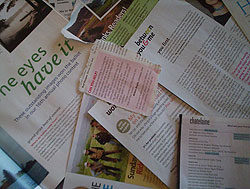Journalists, are you worried about more magazines folding, about the onward march of corporate downsizing, about the steady migration of readers to the Internet?
Of course you are! But fear not. At the Ryerson Review of Journalism, we’ve developed a plan for you to stay in the game. You see, journalists really can benefit from the trend toward reader content.
If more and more editors put a cattle call out to readers to submit questions, ideas and writing – so be it. You are not afraid, because all you need to do to keep your name in print is adjust your style accordingly to conform to the new reality.*
Here are five easy ways you, the beleaguered journalist, can tap into the craze.
GET WIRED
Do you enjoy writing about the news, but hate doing interviews? Is your current events blog just not getting the attention it deserves? Then Wikinews is the place for you. It’s the new branch of the Wikimedia Foundation, best known for its online encyclopedia. Wikinews launched in December 2004 with the aim of providing a free and unbiased alternative news source written by regular people around the world.
However, most of Wikinews’s articles are based on other reports. “There’s less original reporting than we’d like,” admits Nicholas Moreau, one of the site’s nine accredited reporters and a student at Humber College.
According to its mission statement, Wikinews plans to tap into the citizen journalism movement and eventually “provide an alternative to proprietary news agencies like the Associated Press or Reuters.”
There are 784 registered contributors to Wikinews, and you can be one of them. “Anyone can write for Wikinews, as long as they have an Internet connection and are literate in one of the project’s 18 languages,” says Moreau. Click here and start writing.
BE A WOMAN
Reader-supplied content has exploded in women’s magazines. Crack open the January issue of Chatelaineand you’ll see what I mean. You needn’t flip any further than the masthead to find reader input. Here, readers ask staff questions like “What was your first job?” to win prizes.
In her column, executive editor Beth Hitchcock invites readers to answer a monthly question. In fact, readers provide almost all of the content in Chatelaine‘s front-of-book section. There’s an advice column, poll results and stories, all written by readers.
In the November 2005 issue, after former editor Kim Pittaway’s departure, Hitchcock wrote, “We’re more committed than ever to creating the magazine of your dreams” – “your” being the operative word.
Women’s magazines rely on their perceived role as the reader’s friend. The more reader feedback and participation there is, the more in tune with the reader the publication can be.
One of the easiest ways to contribute to women’s magazines is to visit their websites. Canadian Living has a section devoted to contributing to the magazine in different ways.
Sorry guys, but reader interaction is much more limited in men’s magazines. But even if you aren’t blessed with menstrual cramping and a uterus, there’s a place for you. Pose your manly problems to Toro‘s Damage Control advice column at damagecontrol@toromagazine.ca.
START SNAPPING
Now that everyone and their dog own a digital camera, this one is easy. Just cart your camera everywhere you go, taking pictures of everything you see. Enter your favourite shot – along with a mini-essay on why it’s great – in a magazine photo contest, win and become an award-winning photojournalist.
“It’s not a new concept,” says Masthead editor Bill Shields, “although it does seem to be one that is enjoying renewed appeal in these lean times.” Shields points to the annual photo contests in Cottage Life and Canadian Geographic. Pick up the January/February issue of the latter and find several pages of photos provided by its contest winners.
“It certainly reduces your editorial cost-per-page figures,” says Shields.
Editor Rick Boychuk says CG doesn’t publish reader content to save money. “Because we are known for the quality of our photography,” he says, “we tend to attract readers who are interested in photography. Our photo contest is an opportunity for them to speak to us and to other readers in visual terms.”
Newspapers are jumping on the trend, too. When U2 recently visited our nation’s capital, the Ottawa Citizen published stories and photographs submitted by concertgoers. In fact, this fall the Citizen launched a program, originally created by The Washington Post, attempting to attract younger readers by enhancing reader participation. The paper asked students from 13 area high schools to review other school plays. The best reviews were submitted to the paper and printed verbatim.
BEEF UP YOUR CANCON (AND LIVE SOMEWHERE PRETTY)
There’s an entire magazine devoted to you if you a) live in Canada and b) can write. It’s called Our Canada, a magazine made entirely of reader-submitted stories and photographs. It is proof that the reader-supplied content phenomenon is here to stay. The magazine, which is part of Reader’s Digest Canada, launched in January 2004 and now boasts a paid circulation of 238,000.
“To go from zero to 238,000 paid in two years is remarkable,” says Shields. “I can’t think of another magazine that grew such a large and paying readership as quickly.”
Our Canada began when a photo contest for Reader’s Digest yielded 30,000 entries. The corporate heads saw a niche and aimed straight for it. Contributing is easy. All you have to do is fill out the required fields on the online application form.
There are mixed reviews on whether the content of Our Canada is journalism or not. Antoine Tedesco of sceneandheard.ca writes, “The stories are not journalism necessarily, but they are well-written, the photographs of this amazing country are awesome, and the personal stories about times and places past connect you to the people and places that make this country such a wonderful place to live.”
So dust off your patriotism, rev up your nostalgia and start writing. If your story is chosen, Our Canada will send you a rosewood-finish photo box.
GIVE AN INTERVIEW
Now that you’re a full-fledged journalist, it’s time to remember your roots and answer questions, rather than ask them. There’s no better way to direct the content of your favourite magazine than by participating in a poll. If 68 per cent of readers say their New Year’s resolution is to spice up their sex life, you can bet that you’ll soon be perusing an article on how to heat things up in the bedroom.
And there’s no better time to take part in a poll than during a national election campaign. The Toronto Star‘s Speak Out section is in overdrive polling and publishing reader comments on all sorts of election issues.
Another quick ‘n’ easy way to contribute to a magazine is to take part in a survey. Fashion magazine’s Readers’ Choice Beauty Awards, an annual feature since 2003, takes up 10 pages of the magazine’s Winter 2006 issue. In the issue, editor Ceri Marsh writes, “We value knowing the choices you make when it comes to your vanity.”
And, I’m guessing, they also value the 10 editorial pages that come at such a low cost.
* Just don’t expect to get paid. Hey, in times like these, we all have to make sacrifices!
About the author
Carley Fortune was the Production Editor for the Summer 2006 issue of the Ryerson Review of Journalism.


